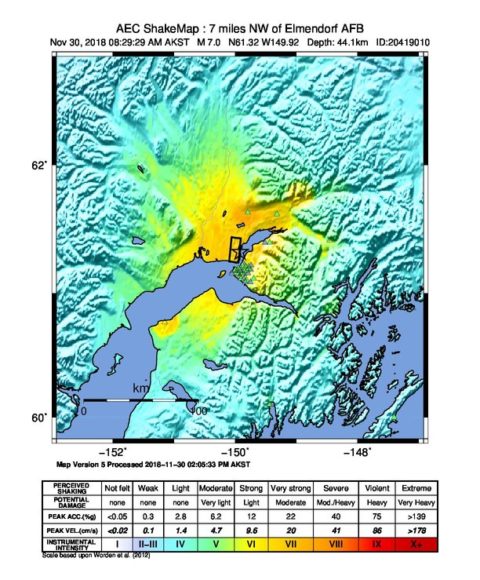

This post is part of a series of sponsored by CoreLogic.
A magnitude (M) 7.0 earthquake struck north of Anchorage, Alaska, on November 30, 2018. Located along the Ring of Fire which sees 81% of the world’s largest earthquakes, Alaska is no stranger to earthquakes. Alaska has experienced several of these devastating earthquakes in the past including the M9.2 in 1964 – the largest U.S. earthquake in recorded history.
Source: https://earthquake.usgs.gov/realtime/product/shakemap/ak20419010/ak/1543619279910/download/intensity.jpg (30 Nov 2018)
The damage caused to property is still being assessed. Although the ground motions impact a very large area, the damage is concentrated in close proximity to Anchorage, Alaska’s most populous city. The 2010 census population of Anchorage is approximately 291,000 persons and the population for the encompassing metropolitan area is over 380,000. In the days following the initial earthquake, over 1000 aftershocks were recorded.
Recovery from this earthquake begins with ensuring the integrity of homes as winter approaches. CoreLogic has rapidly cross-referenced the number of units as compared to the ground motion maps the U.S. Geological Survey (USGS) produces. Derived from the USGS ShakeMap (Version 5, November 30, 2018) the number of homes impacted by strong to very strong ground motion is listed in Table 1. While a number of other homes felt shaking from the earthquake, those experiencing MMI VII (very strong ground shaking) are those of most interest as structural damage is typically observed starting with this level of ground motion. Some damage, especially non-structural damage, may also be experienced at the MMI VI level. The housing units affected by this level of intensity are displayed in Table 1 as well.

As more information becomes available, these numbers can be refined. There are several reports of soil failures in the roadways as well, and it is expected that these soil failures may impact residential areas. The 1964 Anchorage earthquake triggered landslides in the neighborhood of Turnagain Heights. The worst damaged areas in 1964 were turned into a park, but damage from this event is not expected to be as severe as the 1964 event.
The CoreLogic® Insurance and Spatial Solutions mission is to protect and restore homes and businesses from financial catastrophe. Knowing the risk that a structure or homeowner faces is essential to recovering quickly. For residents in Alaska, where the average high temperature in December is still below freezing, recovering quickly is critical.
For more information on how to keep up to date on this event and other catastrophes, visit our catastrophe insight and response site Hazard HQ™.